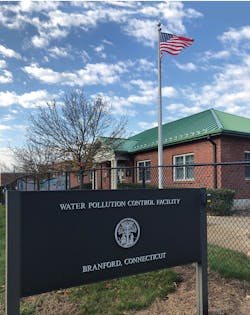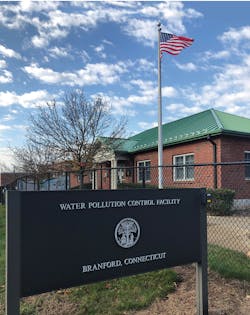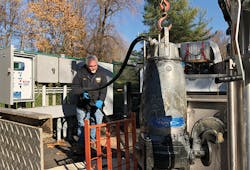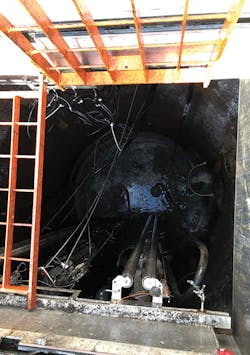Lifting the FOG
Historic town tames its troubles with fats, oils, and grease
By Dan Gregory
Branford, Conn., was first settled in mid-1644 as part of the New Haven Colony and officially renamed in 1653 after the Town of Brentford, England. Branford's center is home to shops, restaurants, and coffee houses that line Main Street, including the Town Green at its center. The Branford Festival, road races, and parades throughout the year add to the quality of life in this shoreline community, which still offers easy access to and from New York, Boston and Hartford.
Administrative building at the Branford Water Pollution Control Facility.
Branford owns and operates a Water Pollution Control Facility on Block Island Road. The facility collects sewage from about 100 miles of sewers and 50 pump stations in Branford, as well as sewage from a portion of North Branford. The Town of Branford Sewer Authority oversees the construction and extension of the sewerage system and has the authority to enact user charges and assessment fees to owners benefiting from the system. The Water Pollution Control Department provides daily operations and maintenance to the system, which serves about 90 percent of existing commercial and industrial areas of the town and almost 85 percent of the residences.
The system was originally built in 1961, when it provided secondary treatment for 1.5 million gallons per day (mgd) of flow. In 1982, the system was expanded and upgraded to treat 4.5 mgd of flow utilizing an oxygen generator to provide secondary treatment and anaerobic digestion for solids reduction. Treated effluent from the plant flows into Branford Harbor and ultimately Long Island Sound. On January 13, 2000, a 30-month construction project began on the new treatment facility. The projected cost totaled $26 million, funded through a combination of State of Connecticut Clean Water Fund grants and two-percent loans. With its completion, the facility now has the capacity to treat 4.9 mgd of flow and provides biological nitrogen removal with an effluent limit of 4 mg/L of total nitrogen.
The sewers and pumping stations collect an average of 3.5 mgd of wastewater and then direct the flow toward the facility for treatment and eventual discharge to Branford Harbor, which is contiguous with Long Island Sound. During the past year, the plant treated over one billion gallons of wastewater. The Branford plant is permitted under a federal NPDES permit for the discharge of treated water and must comply with contaminant thresholds and removal efficiencies. As a rule, the NPDES compliance standards have become more stringent with every five-year permit reissue. The Branford water pollution control facility has consistently met those lower thresholds for pollution parameters required under the recent August 2013 permit reissue.
Maintenance crews are pleased with pump condition following six months of operation.
Pumping Station Woes
Among the 50 pump stations managed by Branford is a station located at Burban Street that had been problematic for some time. There were two primary problems at this station: 1) impeller clogging from modern day trash and raggy, stringy materials; and 2) fats, oils, and grease (FOG) from a nearby nursing home and restaurants, which accumulate and float on the water surface, resulting in a horrendous mess. If town staff did not travel to the station weekly and clean it with a vacuum truck or fire hose, the FOG would congeal and become an even bigger problem, requiring many additional labor hours to resolve. Town staff were spending at least one to two hours with one or two personnel every week at this site. It was becoming a big headache considering the limited resources Branford had for managing 50 pump stations.
MultiSmart Control Panel simplifies control of Flygt N-Pump's advanced features.
To solve these two nagging problems, pumping equipment at the Burban Street station was recently upgraded as part of a capital project, and Branford chose to use Flygt N technology pumps to eliminate clogging issues. Two Flygt NP 3171 HT model submersible pumps were installed, each capable of handling up to 1,300 gallons per minute (gpm) and 63 feet of total dynamic head. These pumps feature explosion-proof, 34-horsepower motors and high chrome impellers. The pumps are also more efficient than their predecessors, which will save Branford money by reducing energy costs.
With N-pump technology, solid objects slide along the tip of the impeller vane inside a relief groove. The guide pin in the insert ring pushes all types of solids away from the center of the impeller, along the leading edge, and out through the relief groove. Deciding to go with N technology proved to be a wise decision: clogging issues were quickly resolved.
However, FOG build-up problems remained, continuing to plague the town. So, Branford began evaluating different solutions, such as mechanical or bubble mixers, knowing all the while that new equipment may or may not have resolved the issue. But the main concern was adding additional mechanical equipment needing maintenance in the basin. The mechanical mixer required routine maintenance itself and bubble mixers have a compressor that not only needed routine maintenance but was also loud and required a heated enclosure.
It's All in the Controls
At this juncture, Branford's local Flygt representative, GA Fleet Associates, approached the town with a possible solution and offered a demo option of a Flygt MultiSmart controller. Following initial discussions, a MultiSmart control panel with a Flygt PumpView3 SCADA system was shipped to the site four weeks later. Manufacturer's representatives and experts were on hand to support the town for the start-up of the controller and setup of the SCADA system.
MultiSmart's wet well cleaning, pump reversal, flow metering, energy calculation and pumping efficiency, and FOG-ring avoiding functions were enabled and continuously monitored remotely by town personnel. Wet well cleaning is highly successful due to both the N impeller and pump reversal features that permit snore cycles to keep the wet well clean. Using phase and energy monitoring, Branford personnel are able to predictively monitor pump efficiency, looking for changes that might require maintenance.
Open hatch grate over wet well reveals guide rails in foreground.
Wet well cleaning was operating every fifth cycle with alternating pumps and snoring. Pumping was continued an additional 30 seconds as the check valves of the pump station were 30 feet away and required this amount of time to ensure the FOG and any other floatable solids were completely pumped out of the station. Although it is not optimal to allow other pumps to snore, these new pumps are designed to run dry if needed because their closed-loop cooling system prevents them from overheating. This operating mode now keeps the wet well clean while the PumpView3 SCADA system provides the town peace of mind through its remote monitoring and operating capabilities.
The new pumps and controls have given Branford a complete solution for its pumping stations. Now the town is interested in converting other problematic pump stations and utilizing MultiSmart functions for additional reasons, such as phase monitoring to prove to the utility company that there are occasionally over- and under-voltage situations at other pump stations. WW
About the Author: Dan Gregory is a wastewater treatment plant class 4 superintendent with over 37 years of experience in the field. He has managed two different plants in the state of Connecticut and has been running the Branford wastewater treatment plant and the collection system for over 6 years. He is dedicated to innovation and tries to improve his collection system capabilities and treatment processes continuously. Dan can be contacted at [email protected].
Circle No. 230 on Reader Service Card




